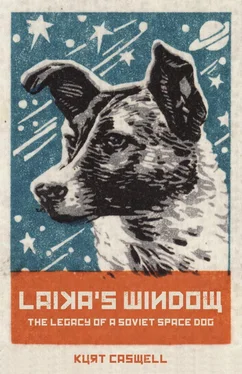Here at the dawn of the Space Age, Korolev was approaching the height of his power and influence, but in the early part of his life he had spent nearly seven years in prison. As a young rocket and aviation engineer and project manager, Korolev was interested in liquid-fueled winged vehicles, while his colleague and rival, Valentin Glushko, wanted to focus on solid-fueled rockets. Piqued by this difference, Glushko and two other colleagues (who had also been arrested) denounced Korolev as a subversive, holding up progress during that period of political repression under Soviet leader Joseph Stalin known as the Great Purge (or sometimes the Great Terror). Paranoid and ruthless, Stalin’s government murdered hundreds of thousands of Soviet citizens, with some estimates putting that number over one million. Millions more died in gulags under forced labor and due to impossible living conditions. It is tempting to regard Glushko as the villain in this story, but as many historians point out, Stalin made everyone the enemy of everyone else.
Stalin’s secret police arrested Korolev early in the morning on June 27, 1938, at his home in Leningrad (now Saint Petersburg). His wife stood by helplessly as he was taken away and shipped off in a boxcar, unable to say goodbye to his three-year-old daughter, Natasha, asleep in the next room. During his imprisonment, Korolev’s wife divorced him.
Tortured into a false confession and sentenced to ten years of imprisonment, Korolev was transferred from prison to prison, and then in 1939 he was sent to Kolyma, a gulag in far eastern Siberia notorious for deplorable living conditions, hard labor, and torture. In Kolyma: The Arctic Death Camps , Robert Conquest writes that conditions were so bad that more than two million people died at Kolyma alone. By the time Korolev’s nightmare ended, he had developed a heart condition, suffered a broken jaw, and lost all his teeth. He spent the remaining years of his imprisonment in sharagas , prisons for intellectuals, especially engineers and scientists. He was discharged in 1944, but his charges were not officially dropped until 1957, the year Sputnik I and II went up. In 1945 Korolev was given the Badge of Honor and then commissioned a colonel in the Red Army. Later, when news surfaced that the US planned to launch an artificial Earth satellite as part of the IGY, Korolev convinced the Soviet Academy of Sciences and the government that he could beat the Americans into orbit. And he did.
It is a wonder that men like Korolev devoted their lives to the government that condemned and imprisoned them. How do we explain this? Perhaps love of country and the hope for a better future are enough, but Korolev’s greater love had always been his work: design and engineering, space exploration and travel, and the dream of traveling to distant worlds. He wanted to go to Mars. He was the kind of man who wrote his own story, who cleared obstacles from his path as he went, no matter the cost. He was fixated on a future he had determined for himself and for humankind. No government was going to get in the way of that. In his book Korolev , James Harford writes that in winter 1965 Korolev spoke with Josef Gitelson, a scientist who worked primarily on life support and ecological systems for the USSR’s Institute of Biophysics. Korolev told Gitelson, “I have a short time before me, maybe ten years, and I want to send humans to the nearest planet.” That nearest planet was Mars. “His original plan, even before concentrating on the Moon project,” writes Harford, “was to launch a cosmonaut around Mars.” He launched two uncrewed probes to Mars during his lifetime, but both failed.
Heavily built and muscular, with dark brown eyes and an unstoppable intelligence, Korolev’s great talent was not so much design and engineering but project management, organization, leadership. He was a master collaborator, a man his team both respected and feared. He was fast to anger but lavishly generous. If Korolev told you to do something, you did it. In Challenge to Apollo , Asif Siddiqi reports that engineer Anatoliy Abramov wrote: “Korolev’s diatribes were the stuff of legend, and he was a master at it; his eyes would flash, his words would destroy yours, he would threaten to send you home walking between the railway tracks.” Despite such harshness, Korolev understood that in a system where people who worked hard earned little more than people who didn’t, his team would benefit if he offered incentives by way of bonus money and elaborate vacations. “A real king,” Anatoliy Kirillov calls him in Roads to Space , an oral history of the early days of the Soviet space program, “the undisputed boss of everything.” That role as undisputed boss made him sometimes difficult to work with, while his prison years had left him soberingly pragmatic, even prone to dark moods. He was fond of proclaiming, “We will all vanish without a trace.”
Like Laika in her capsule, Korolev was a kind of prisoner inside his work, as the Soviet government saw to it that he lived the life of a vanished man. His identity was known only to a select few in the government, to his family, and to the people he worked with. To most Soviets and to the outside world, he was known only as the chief designer. US intelligence did not know his name until a year before his death, and it was only after his death that the Soviets released his name to the world. Were his identity known, the Soviets feared, the US would assassinate him. So Korolev lived and worked his entire life in anonymity. Perhaps if he had been known to the world and lived in the light of his work, it would have helped him shrug off his great darkness. Perhaps not. But one thing the Soviets got right: genius is not rooted in the individual but in the community, not in the chief designer alone but in his team. It is a collaboration of great minds, each doing their part, nurtured and driven by competition. Korolev’s genius was in the way he orchestrated all the parts to make them work together. In his mind was a future he wanted to build, and he found the will and the people to help him build it. Among the great achievements of Korolev and his team is a string of world firsts: the first artificial Earth satellite ( Sputnik I , 1957); the first biological satellite ( Sputnik II , 1957); the first moon landing, uncrewed ( Luna 2 , 1959); the first human being in space (Yuri Gagarin, 1961); and the first spacewalk (Alexey Leonov, 1965).
Korolev’s genius is an extension of the work of earlier and contemporary scientists and engineers who informed and inspired him. First, take Russia’s Nikolai Kibalchich (1853–1881), who was hanged for building the explosives used to assassinate Tsar Alexander II in 1881. Imprisoned and awaiting execution, Kibalchich wrote down what he called his grand idea, essentially that explosives could be used not only to kill a tsar but also to propel a flying machine through the atmosphere. Soviet science writer Yakov Perelman later described his grand idea as “the first step in the history of spaceflight.” Konstantin Tsiolkovsky (1857–1935), a high school math and physics teacher, worked on designs for a spacecraft capable of taking men to distant planets, namely Mars. He predicted that satellites and crewed space stations would one day orbit the Earth, and that this might be achieved by use of a rocket burning liquid fuels. He is best known for the Tsiolkovsky equation, his calculation for the speed required for a spacecraft to achieve Earth orbit—five miles per second, or about 18,000mph—and that this speed could be achieved by a multistage rocket fueled by burning liquid hydrogen and oxygen. These same basic principles govern rocketry today. “There is no doubt, though,” writes Harford, “about the degree to which Tsiolkovsky’s works gave direction to Sergei Korolev. In simple fact, Korolev began to build what Tsiolkovsky had conceived.” Yet for Tsiolkovsky, what he had conceived was a mechanical means to a much greater achievement: happiness for all beings in the universe. In order to achieve happiness (what Tsiolkovsky defined as the absence of suffering), humans had to understand the workings of the universe, which was only possible by learning to live and work in space. It was inevitable, he believed, that human beings would one day live on other planets throughout our solar system and eventually spread across the galaxy. For Tsiolkovsky, our technology, our will and choice, our migration out among the stars, would one day drive our evolution, and we would then be able to remake ourselves into something new, something better.
Читать дальше












